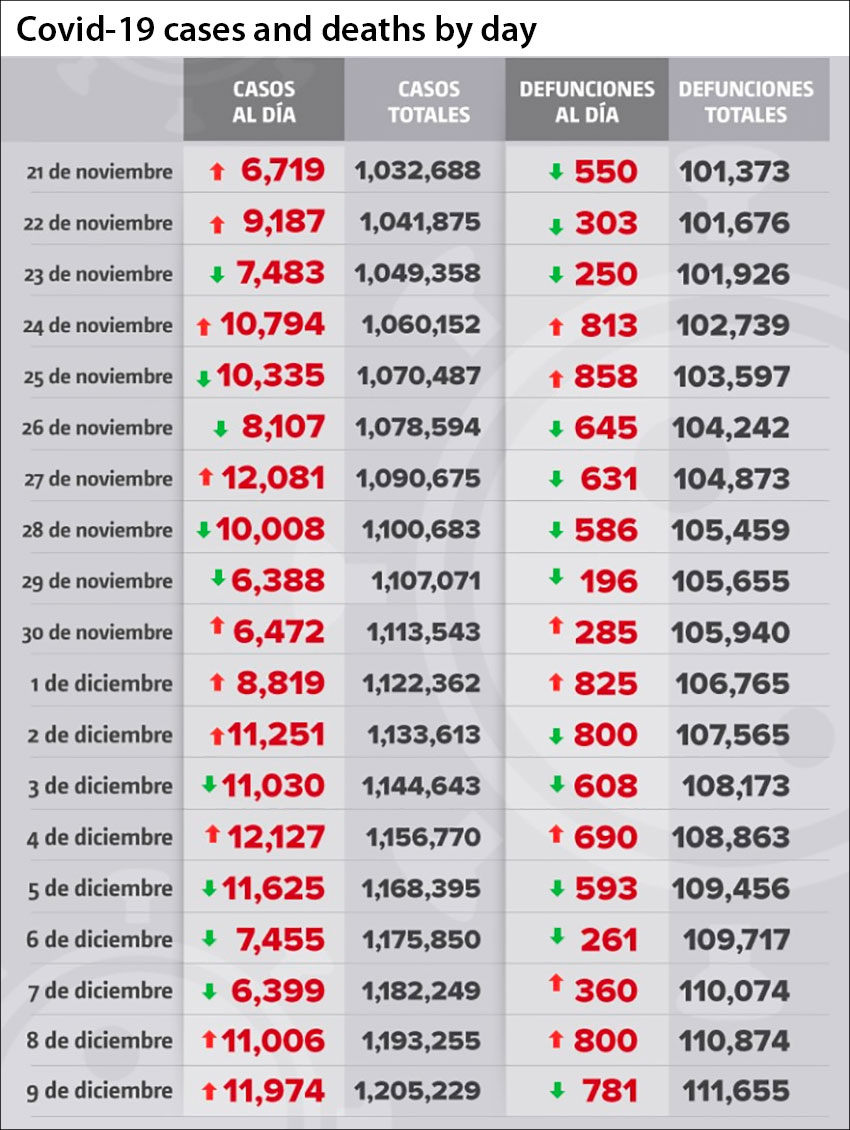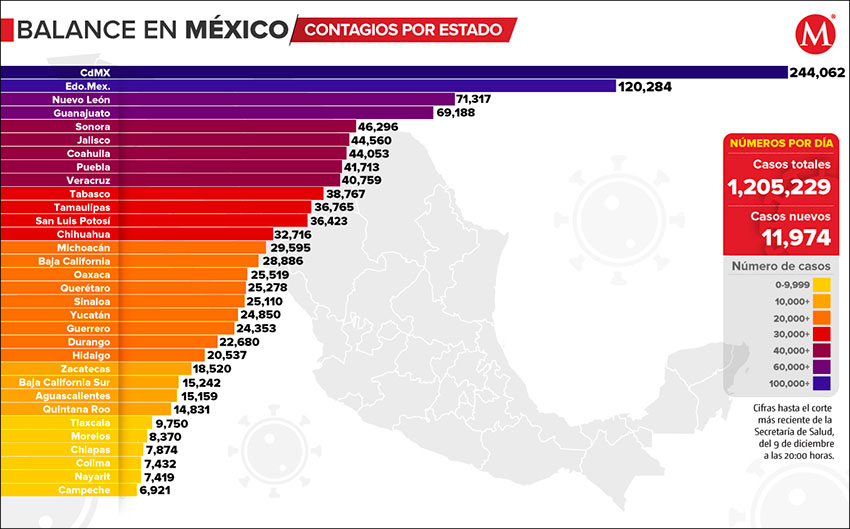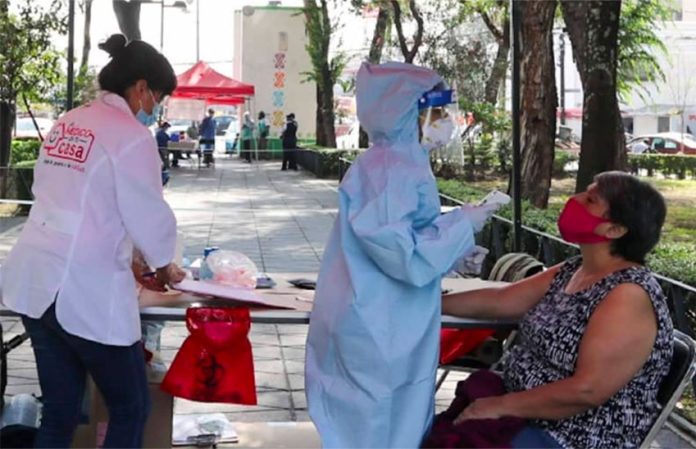The Pan American Health Organization (PAHO) has warned that the coronavirus pandemic is worsening across the region, noting that Mexico, the United States and Canada are all recording high case numbers.
In a press briefing on Wednesday, PAHO director Carissa F. Etienne said the Americas region in recent has weeks been experiencing “the highest levels of new Covid-19 cases since the start of the pandemic.”
“In North America, Canada and the U.S. are reporting jumps in weekly case counts. In Canada, infections continue to climb, and record deaths have been reported in some provinces. Meanwhile, in the U.S., daily case counts are reaching 200,000 and more than 100,000 people are currently hospitalized due to Covid illness,” she said.
“Mexico is also experiencing a resurgence in cases in the state of Baja California, near the U.S. border.”
Indeed Baja California is one of just two red light “maximum” risk states on the federal government’s coronavirus stoplight system, the other being Zacatecas.

The federal Health Ministry estimates that there are almost 2,800 active cases in the northern border state, the fifth highest total among Mexico’s 32 states after Mexico City, México state, Guanajuato and Nuevo León.
There are more than 75,000 estimated active cases across the country while Mexico’s accumulated tally passed 1.2 million on Wednesday. The Health Ministry reported 11,974 new cases – the third highest single-day tally of the pandemic – increasing the total to 1,205,229.
While Mexico’s daily tally of cases is just a fraction of its northern neighbor – more than 218,000 new cases were reported in the United States on Wednesday, according to The New York Times – the testing rate here is much lower than in the U.S., making it inevitable that large numbers of cases, especially mild and asymptomatic ones, go undetected.
As of Wednesday, the United States per-capita testing rate was about 27 times higher than that of Mexico.
Even with a very low testing rate, Mexico ranks 12th in the world for total cases, according to data compiled by Johns Hopkins University, and fourth for confirmed Covid-19 deaths with 111,655, including 781 reported on Wednesday.
Immunization with the Pfizer vaccine is expected to begin in Mexico this month but only a very small fraction of the population is likely to be vaccinated by the end of winter, meaning that case numbers and deaths will in all likelihood remain high in the coming months.

PAHO director Etienne said the continuing rise in infections in North America is “particularly worrisome” as winter approaches in the Northern Hemisphere.
“Seeking refuge from the cold, people may be tempted to gather indoors in poorly ventilated areas – the perfect conditions for the virus to spread,” she said.
Coronavirus figures and trends across the Americas “make it clear that our region must redouble preventive measures, especially in preparation for the year-end holidays.”
“Now is not the time to relax,” she said.
Etienne said PAHO is hopeful that Covid-19 vaccines will help contain the pandemic but noted: “This will take time and advance planning.”
She said PAHO is convening members states this week to an extraordinary session “where we’ll meet with the ministries of health of our region to discuss the preparation for vaccine roll-out and purchasing and distribution of Covid-19 vaccines in the region through our revolving fund.”

Mexico last week struck a deal with Pfizer to purchase 34.4 million doses of its vaccine, while Foreign Minister Marcelo Ebrard announced Wednesday that Health Minister Jorge Alcocer had signed an agreement to buy 35 million doses of China’s CanSino Biologics vaccine.
“More options for Mexico,” Ebrard wrote on Twitter without citing an expected arrival date for the CanSino vaccine, which has only been approved for use in the Chinese military and whose efficacy is not publicly known.
The government also has an agreement to purchase 77.4 million doses of the AstraZeneca/Oxford University vaccine, which was shown to have up to 90% efficacy in phase 3 trials. It has not yet been approved for use in any country.
As Mexico waits for vaccines to arrive and prepares to implement its vaccination plan, it has the more immediate task of providing care for the ill as the health system comes under increased pressure from the recent increase in case numbers.
Data presented by the Health Ministry at its Wednesday night press briefing showed that 15,312 coronavirus patients are currently in hospitals across Mexico, including 3,515 in beds with ventilators.
The national occupancy rates for general care beds and critical care beds are 41% and 33%, respectively.
According to federal data, 76% of general care beds and 63% of beds with ventilators are currently in use in Mexico City. The figures in both categories are the highest among the 32 states.
However, the Mexico City government says the overall occupancy rate is only 60%. Mayor Claudia Sheinbaum said this week that the discrepancy is because authorities in the capital have more detailed and up-to-date information about the health system in the capital, including information about the addition of new hospital beds.
Nevertheless, Mexico City government data shows that 30 of 44 public hospitals in the capital have occupancy rates above 80%.
Among those with occupancy rates of 100% in general care beds are the National Institute of Respiratory Illnesses, the Tacuba General Hospital, the La Raza National Medical Center and the Ajusco Medio General Hospital.
Across the capital’s 16 boroughs, 4,235 coronavirus patients are in hospital including 958 on ventilators.
Mexico City recorded 5,056 new cases on Wednesday – 42% of the national total – increasing the capital’s accumulated tally to 244,062. Almost 28,000 cases in the city are considered active.
Mexico City registered 126 additional fatalities on Wednesday, lifting the official death toll to 18,516. The latter figure represents 16.5% of the national Covid-19 death toll, meaning that about one in six fatalities in Mexico attributed to the infectious disease occurred in the capital.
Mexico News Daily
